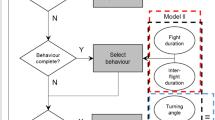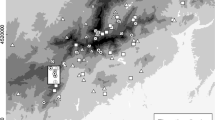Abstract
Migration by flight is essential for insects living in patchy landscapes and knowledge about variability in habitat patch structure and quality is important for the development of theory concerning insect dispersal polymorphisms. However, few studies provide more than anecdotal evidence about habitat change in time and space and its effects on insect survival and reproduction. Here I show how habitats and resource density of a lygaied bug,Lygaeus equestris, change in a patchy landscape over a seventeen year period. Although habitat patches per se are very stable, there are large temporal fluctuations in per capita food resources. Food seems to be limiting only in some years, and there may be periods of several years when populations change due to weather disturbance. Between-patch variation in reproductive success is large. Furthermore, the relative favourability of patches changes between years. There are also distance effects; in some years distances to suitable hibernation sites affect reproductive success. Long fliers experience more variable success, and sometimes extreme success, when compared with short fliers. The importance of movements from outlying areas also changes with time. The insect is thus faced with a habitat templet which varies strongly on many temporal and spatial scales.
Similar content being viewed by others
References
Boer, P. J. den (1970) On the significance of dispersal power for populations of Carabid-beetles (Coleoptera, Carabidae).Oecologia 4: 1–28.
Dingle, H. (1991) Evolutionary genetics of animal migration.Amer. Zool. 31: 253–264.
Gunn, A. and A. G. Gatehouse (1993) The migration syndrome in the African armyworm moth,Spodoptera exempta: allocation of resources to flight and reproduction.Physiol. Entomol. 18: 149–159.
Rankin, M. A. and J. C. A. Burchsted (1992) The cost of migration in insects.Annu. Rev. Entomol. 37: 533–559.
Roff, D. A. (1991) Life history consequences of bioenergetic and biomechanical constraints on migration.Amer. Zool. 31: 205–215.
Roff, D. A. (1992)The evolution of life histories. Chapman and Hall, New York.
Roff, D. A. and D. J. Fairbairn (1991) Wing dimorphisms and the evolution of migratory polymorphisms among the Insecta.Amer. Zool. 31: 243–251.
Sillén-Tullberg, B. and C. Solbreck (1990) Population dynamics of a seed feeding bug,Lygaeus equestris. 2. Temporal dynamics.Oikos 58: 210–218.
Slansky, F. Jr. (1980) Food consumption and reproduction as affected by tethered flight in female milkweed bugs (Oncopeltus fasciatus).Entomol. Exp. Appl. 28: 277–286.
Solbreck, C. (1972) Sexual cycle and changes in feeding activity and fat body size in relation to migration inLygaeus equestris (L.) (Het., Lygaeidae).Entomol. Scand. 3: 267–274.
Solbreck, C. (1976) Flight patterns ofLygaeus equestris (Heteroptera) in spring and autumn with special reference to the influence of weather.Oikos 27: 134–143.
Solbreck, C. (1978) Migration, diapause, and direct development as alternative life histories in a seed bug,Neacoryphus bicrucis. pp. 195–217.In H. Dingle (ed.)Evolution of insect migration and diapause. Springer, New York.
Solbreck, C. (1985) Insect migration strategies and population dynamics.In M. A. Rankin (ed.)Migration: mechanism and adaptive significance. Contr. Marine Sci., Suppl. 27: 641–662.
Solbreck, C. (1991) Unusual weather and insect population dynamics:Lygaeus equestris during an extinction and recovery period.Oikos 60: 343–350.
Solbreck, C. (1995) Long-term population dynamics of a seed-feeding insect in a landscape perspective. pp. 279–301.In N. Cappuccino and P. W. Price (eds.)Population dynamics: new approaches and synthesis. Academic Press. (in press)
Solbreck, C., D. B. Anderson, and J. Förare (1990) Migration and the coordination of life-cycles as exemplified by Lygaeinae bugs. pp. 197–214.In F. Gilbert (ed.)Insect life cycles: genetics, evolution and co-ordination. Springer, London.
Solbreck, C. and B. Sillén-Tullberg (1986) Seed production and seed predation in a patchy and time-varying environment. Dynamics of a milkweed—tephritid fly system.Oecologia 71: 51–58.
Solbreck, C. and B. Sillén-Tullberg (1990) Population dynamics of a seed feeding bug,Lygaeus equestris. 1. Habitat patch structure and spatial dynamics.Oikos 58: 199–209
Southwood, T. R. E. (1977) Habitat, the templet for ecological strategies?J. Anim. Ecol. 46: 337–365.
Stearns, S. C. (1992)The evolution of life histories. Oxford University Press, Oxford.
Wiens, J. A. (1989) Spatial scaling in ecology.Funct. Ecol. 3: 385–397.
Author information
Authors and Affiliations
Rights and permissions
About this article
Cite this article
Solbreck, C. Variable fortunes in a patchy landscape —The habitat templet of an insect migrant. Res Popul Ecol 37, 129–134 (1995). https://doi.org/10.1007/BF02515770
Received:
Accepted:
Issue Date:
DOI: https://doi.org/10.1007/BF02515770




